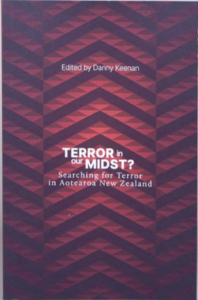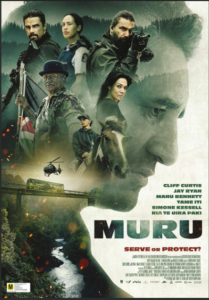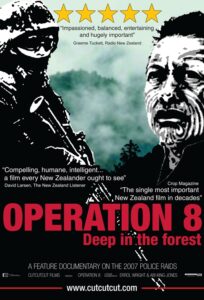Twenty-three years ago, the global ‘war on terror’ arrived in New Zealand. In part a consequence of international fears of the spread of terrorism, following the attacks on the USA of 11 September 2001, these New Zealand raids also contained elements of State coercive activity, which was colonial in origin, arising from an historic fear of Māori with guns.
#
 The Raids
The Raids
On 15 October 2007, private homes throughout New Zealand were raided by squads of police, for the most part in full riot gear, carrying machine guns and handguns with knives strapped to their black garments. The raids occurred at dawn, under cover of darkness.
They smashed doors, windows and furniture, arresting people, confiscating computers, cameras, electronics, files, and papers, searching for incriminating material to support charges under the Terrorism Suppression Act 2002.
One of those arrested was Vietnam veteran Tuhoe Lambert, who lived in South Auckland with his family. At 6am, the police arrived, ordering the whole family into the street at gunpoint, including his 12-year-old daughter, Patricia. The house was then ransacked.
Later that morning, the police occupied and locked down Ruātoki, a small Māori town on the western edge of the Urewera Valley.
The entire areas around Ruātoki and Taneātua were cut off. People were prevented from leaving their homes. Cars were stopped; occupants were ordered out at gunpoint. They were then searched and photographed. According to some witnesses, a school bus full of children was boarded by armed police.
Reporters from a local paper soon arrived – the pictures they took went around the world.
‘A gross breach of civil rights’
According to Tuhoe kaumātua Tamati Kruiger, a gross breach of civil rights occurred at Ruātoki that day – detaining people for hours without food or water, subjecting women to body searches, herding people into sheds while property searches were underway, and photographing onlookers near the roadblock entrance.
One young woman, Annie Rangihika, 17, was searched in full public view. When she was later approached by the New Zealand Herald, the Whakatane High School student declined to comment, saying only that she would never forget what happened.
At least 17 people around New Zealand were arrested. But, said Mr Kruiger, this did not include people taken from Ruatoki to Rotorua for questioning, before being released. Police at Te Ngae station had denied people legal representation, he claimed, and had moved them around police stations, thereby confusing concerned family and friends.
During a police press conference later that day, the police commissioner talked about the ‘terror raids’, thereby placing the language of the ‘war on terror’ into the public domain.
The raids had been necessary, he said, because certain individuals had been identified as posing a dangerous threat to the country’s peace and security. Eight key activists had attended terrorist training camps in Te Urewera, he alleged, learning all about civil instruction, assassination and napalm bombing.
Their ring leader was Tuhoe rangatira, Tame Iti, who stood accused of arranging and conducting these terrorist training camps. Iti’s house was raided, while he was asleep. At gunpoint, Iti, who is not a young man, was made to lie face down on the floor.
Those 17 arrested later appeared in court, charged with a range of alleged arms offences. Charges under the terrorism legislation would soon follow, it was said, once the police had amassed their evidence. But the police case, and their evidence, never made it to court.
The Solicitor General Intervenes
On 9 November 2007, Solicitor General, Dr David Collins, reported that, having reviewed all of the intercepted evidence obtained by the police, he could not permit the material to be entered into court. He therefore refused to allow charges to be laid under the Terrorism Suppression Act 2002.
This was because the 2002 Act was ‘incoherent and unworkable’, he said. The Act could not be applied to those arrested in Ruātoki and other undisclosed locations. The Act could only apply after alleged terrorism acts had occurred, not before.
The Solicitor General’s ruling constituted a dramatic set back for the government, and the police. According to John Minto, the ruling proved that ‘no domestic terrorist cells existed’. The ransacking and raids had reaped no rewards for police.
Instead, he said, the police and politicians had done a great disservice to the country, exacerbated by their continuing use of words like ‘terror’ to justify their activities, imbuing their raids with a false moral purpose. Whole communities had been traumatised and civil liberties threatened, he said.
Māori Protest the Raids
 Meantime, discontent amongst Māori had grown. On 12 November 2007, on the day that the last of the 17 arrested were finally released on bail, a hikoi left Taneātua, heading for Wellington. 1500 peole eventually made it to Parliament, only to find the gates locked shut.
Meantime, discontent amongst Māori had grown. On 12 November 2007, on the day that the last of the 17 arrested were finally released on bail, a hikoi left Taneātua, heading for Wellington. 1500 peole eventually made it to Parliament, only to find the gates locked shut.
Labour Ministers Parekura Horomia and Nania Mahuta spoke to the protesters, but they were loudly challenged and derided, their pleas for Māori to ‘wait and see’ falling on deaf ears.
According to Nicky Hager, the raids had constituted a ‘colossal over-reaction, a gigantic anti-terror operation where there were no terrorists. The government, armed with new legislation, resources and an emboldened police force, had instituted the raids of 15 October 2007, confident that terrorism and insurrection would be found and rooted out.
But, like Sir Galahad who had searched in vain for the Holy Grail, officers had stumbled about, hoping that one day, they would set eyes on the prize. But such a policy came only at the continuing expense of visiting trauma, misery, and despair upon ordinary New Zealanders.
Further Sources
 To obtain a copy of our book Terror in Our Midst, see Huia Publishers, Wellington. A limited reprint of this publiscation was released in 2025.
To obtain a copy of our book Terror in Our Midst, see Huia Publishers, Wellington. A limited reprint of this publiscation was released in 2025.
For a newspaper version of this article above above, click here – Terrorising Maori.
Also, in 2011, an excellent documentary was released on the Urewera raids, entitled Operation Eight. This documentary was in part based on a book of the same name, Operation 8, containing a collection of memories from many of those unfortunate enough to be caught up in the raids, which extended far beyond Ruātoki to include Auckland.
In 2022, a movie was also made based on these raids at Ruātoki. The movie was entitled Muru and starred well-known Māori actors Cliff Curtis and Manu Bennett. One of this movie’s producers was Tama Iti.



